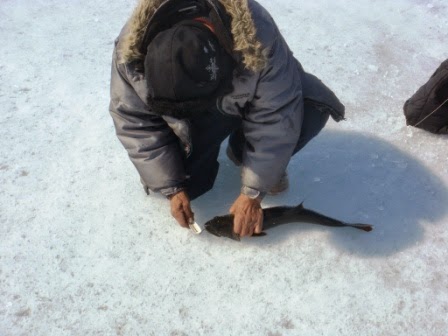In Nunavut, 'going out on the land' is akin to going hunting or fishing; the latter, in this case. As soon as the weather begins to warm up (again, for you Southerners, 'warm' will appear to be a misnomer) in late April, the high school organizes land trips for its senior grades, where elders will take students onto the lake to teach them how to ice-fish. Well, to be accurate, how to cut a 7-feet deep ice well so that the relatively easy fishing part can happen. As mentioned, this is perspective for anyone not from Nunavut. The weather is relatively warm now, so the lake is only frozen to a depth of 7 feet. Only. Outside of Baker Lake, the only thing I can think of made of ice that thick is what caused the Titanic to sink.
Anyway, we set out early in the morning, and our trusty guides loaded us into homemade kamatiks, or wooden sleds, which were towed by snowmobiles along a bumpy path out to an area called Prince River Point. (You can see one of the elders repairing the sled runners below).
Anyone who had money had to bury it before we left, as having money on one's person on a trip to the land is considered bad luck. I wish I'd brought a pillow to soften the bone-jarring thumps incurred along the way. That aside, we couldn't have asked for a more perfect day. It was almost windless out on the lake, so we didn't bother setting up the tent, and instead focused our efforts on fixing the auger, which failed to start.
 |
| Just a minute while we work on the auger! |
Undaunted, we began manually digging our ice fishing holes. I should note there that I had only a cursory idea of how much effort goes into a fishing hole, especially when there is 7 feet of ice to chop through.
The tool being used is essentially a 7 foot long flat-bladed spear, and the best method is to chop downwards, then twist the blade in a rough circle. After you get tired of chopping, which happens quite quickly, the next step is to use a rounded shovel to scoop the ice out of the hole. What makes it more challenging is that the hole fills with water about halfway down, so you have to carve the hole more by feel than visually. On average, it took about an hour to finally break through the ice. One of the elders on our trip, is the current Baker Lake (and possibly Nunavut-wide) record-holder for digging the fastest ice hole, which he clocked in at an incredible sub-15 minutes.
Once we had the first hole cut, we scooped some of the virgin ice into pots and kettles to boil water for what would later become tea and delicious caribou stew, made by another elder.
She and another elder also made fantastic bannock, which has two key ingredients - flour, and lard. A little scoop of peanut butter for protein, and Bob's your uncle.
One of the first fish caught was done so with one of the smallest hooks, which made it even more impressive. Later that day, the second and last fish of the day was caught, an impressive 8-pounder.
Other highlights of the day: running into a few locals who stopped by to say hello, being regaled by an elder with tales of meeting and touring with the legendary John Denver (he now translates English country songs into Inuktitut, and played his version of 'Goodnight Irene' for me), and watching one of my students try to sneak up on a ptarmigan on the ice.
Truly, it was a beautiful day out on the lake, and I know I will miss moments like these later on.
-J






No comments:
Post a Comment
Note: Only a member of this blog may post a comment.